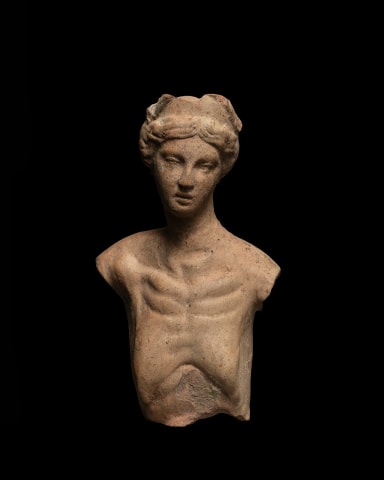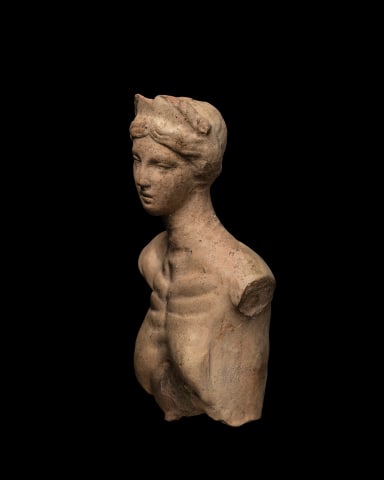Greek statuette of a nude torso, Smyrna, c.3rd century BC
Terracotta
Height: 12cm
11261 TA
%3Cdiv%20class%3D%22title_and_year%22%3E%3Cem%3EGreek%20statuette%20of%20a%20nude%20torso%3C/em%3E%2C%20%3Cspan%20class%3D%22title_and_year_year%22%3ESmyrna%2C%20c.3rd%20century%20BC%3C/span%3E%3C/div%3E%3Cdiv%20class%3D%22medium%22%3ETerracotta%3C/div%3E%3Cdiv%20class%3D%22dimensions%22%3EHeight%3A%2012cm%3C/div%3E
A composite human torso with the diademed head of an attractive, youthful girl, the breasts of a decrepit woman, and the back of a muscular man. The head is turned...
A composite human torso with the diademed head of an attractive, youthful girl, the breasts of a decrepit woman, and the back of a muscular man. The head is turned to the left, gazing downward, the bones of the sternum and clavicle accentuated above exaggeratedly sagging breasts. The arms are finished just below the shoulders, the lower half of the figure broken away. On the back are the remains of a red wax seal, possibly an Italian export seal from the 19th century. Mould made and finished by hand, broken at the waist and shoulders, loss to top of diadem, tip of nose restored.
This intriguing sculpture, represents three stages of adulthood, shows both the male and female form, and personifies wealth through the diademed head, and poverty through the emaciated body. It is an unusual genre type, other examples of which have been found in Smyrna, in modern day Turkey. They all focus on the torso, lack arms and legs, and seemingly all had heads, though very rarely have these survived intact. Most of the statuettes are crude, so the present example can be counted among the best. The purpose of these figures is unknown, but it is in Smyrna that we find the greatest variety in the representation of the human form in terracotta from antiquity.
Provenance
Louis-Gabriel Bellon (1819-1899), St. Nicholas-les-Arras,
France
Bellon was one of the greatest French collectors of the
19th century. Making his fortune in the textile industry,
he began to buy and collect archaeological pieces from
the Mediterranean world. Until the end of the 1870s he
accompanied Auguste Ternick in archaeological excavations
in the Arras region. Some of his collection can be seen at the
Museum of National Antiquities of Saint-Germain-en-Laye,
the Petit Palais in Paris, the Louvre Museum, and the Berck-sur-Mer museum.
Literature
For the genre compare S. Mollard-Besques Musée National du Louvre: Catalogue Raisonné des Figurines et Reliefs en terre-cuite Grecs, Étrusques et Romains, Vol. III (Paris, 1972), pl.231d and pl.233f







